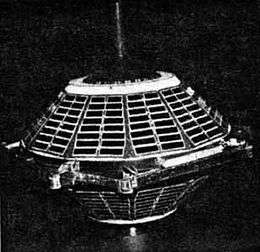S-45A
S-45A was an American satellite, which was lost in a launch failure in 1961. The satellite was intended to operate in a highly elliptical orbit, from which it was to have provided data on the shape of the ionosphere,[1] and on the Earth's magnetic field.[2] It was part of the Explorer programme, and would have been designated Explorer 12 had it reached orbit. It was the second of two identical satellites to be launched; the first, S-45, had also been lost in a launch failure, earlier in the year.[2]
 An S-45 satellite before launch | |
| Mission type | Ionospheric |
|---|---|
| Operator | NASA |
| Mission duration | Failed to orbit |
| Spacecraft properties | |
| Launch mass | 33.6 kilograms (74 lb) |
| Start of mission | |
| Launch date | 24 May 1961, 19:48:05 UTC |
| Rocket | Juno II AM-19G |
| Launch site | Cape Canaveral LC-26B |
| Orbital parameters | |
| Reference system | Geocentric |
| Regime | Highly elliptical (planned) |
Explorers | |
S-45A was launched aboard a Juno II rocket, serial number AM-19G. It was the final flight of the Juno II.[3] The launch took place from Launch Complex 26B at the Cape Canaveral Air Force Station at 19:48:05 UTC on 24 May 1961.[3] The system which was intended to ignite the second stage malfunctioned, and as a result that stage failed to ignite.[4] The rocket failed to achieve orbit.[5]
References
- "Explorer S45A". NSSDC Master Catalog. NASA. Retrieved 14 July 2010.
- Wade, Mark. "P-14". Encyclopedia Astronautica. Archived from the original on 13 June 2010. Retrieved 14 July 2010.
- McDowell, Jonathan. "Launch Log". Jonathan's Space Page. Retrieved 14 July 2010.
- Krebs, Gunter. "Explorer: S-45". Gunter's Space Page. Retrieved 14 July 2010.
- "Explorer Program". Mission and Spacecraft Library. NASA. Archived from the original on 27 January 2008. Retrieved 14 July 2010.
.png)